sensor RENAULT ESPACE 2012 J81 / 4.G Owners Manual
[x] Cancel search | Manufacturer: RENAULT, Model Year: 2012, Model line: ESPACE, Model: RENAULT ESPACE 2012 J81 / 4.GPages: 267, PDF Size: 8.95 MB
Page 65 of 267
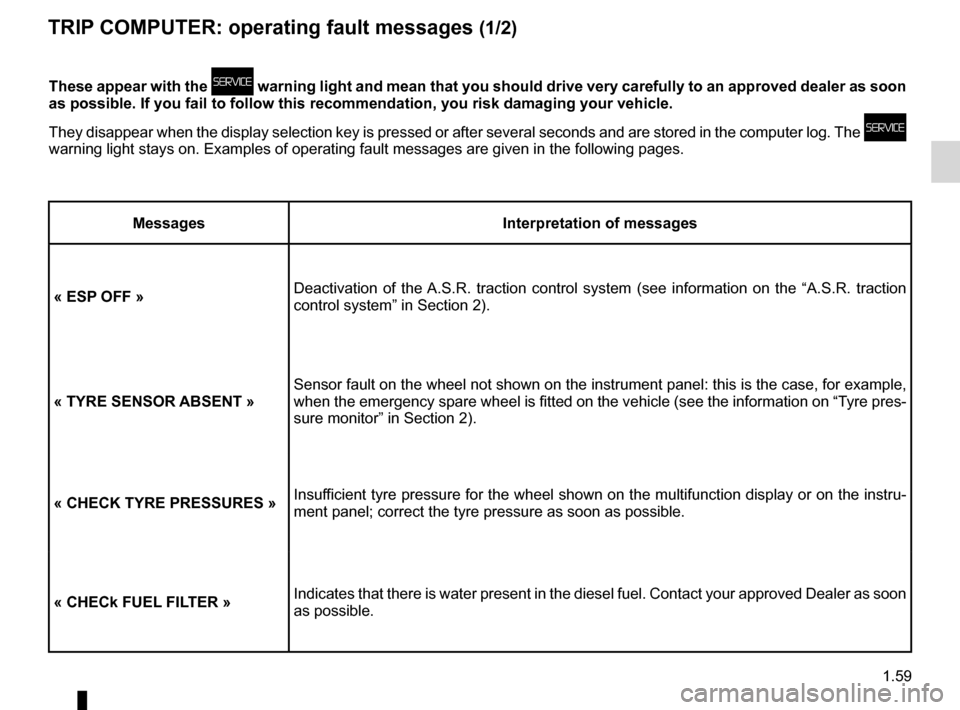
1.59
ENG_UD24101_1
Ordinateur de bord : messages d’anomalies de fonctionnement (X81 - J\
81 - Renault)
ENG_NU_932-3_X81ph3_Renault_1
TrIP cOMPUTer: operating fault messages (1/2)
These appear with the ú warning light and mean that you should drive very carefully to an approved dealer as soon
as possible. If you fail to follow this recommendation, you risk damagin\
g your vehicle.
They disappear when the display selection key is pressed or after several seconds and are stored in the computer log. The
ú
warning light stays on. Examples of operating fault messages are given i\
n the following pages.
Messages Interpretation of messages
« esP Off » Deactivation of the A.S.R. traction control system (see information on the “A.S.R. traction
control system” in Section 2).
« TYre sensOr aBsenT »Sensor fault on the wheel not shown on the instrument panel: this is the case, for example,
when the emergency spare wheel is fitted on the vehicle (see the information on “Tyre pres-
sure monitor” in Section 2).
« cHecK TYre PressUres »Insufficient tyre pressure for the wheel shown on the multifunction display or on the instru-
ment panel; correct the tyre pressure as soon as possible.
« cHeck fUeL fILTer » Indicates that there is water present in the diesel fuel. Contact your approved Dealer as soon
as possible.
Page 77 of 267
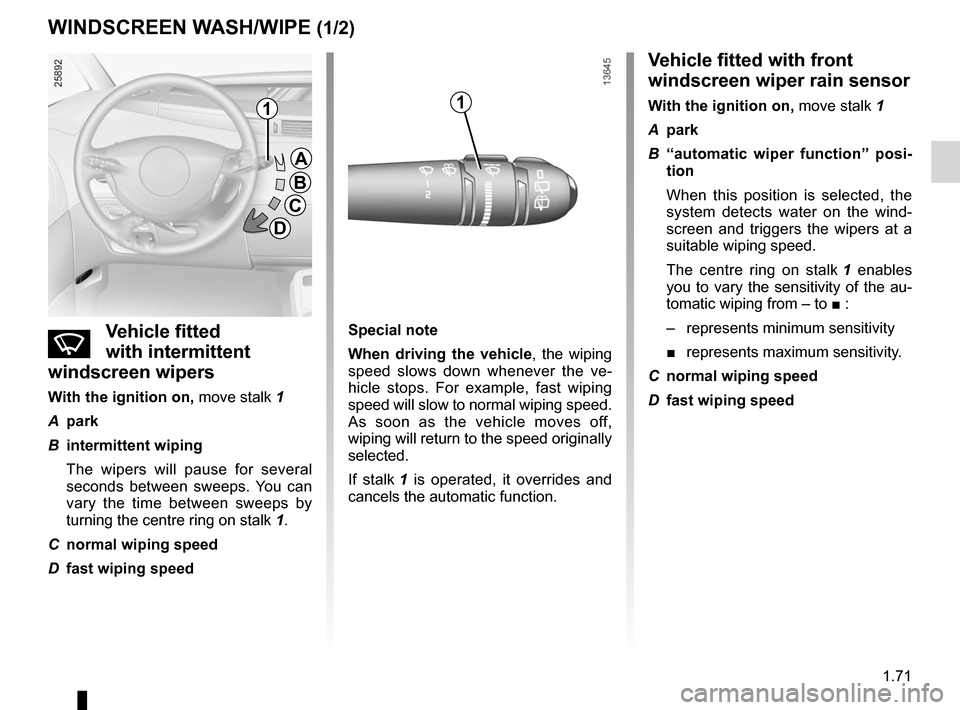
wipers ................................................... (up to the end of the DU)
windscreen washer ............................... (up to the end of the DU)
1.71
ENG_UD20355_1
Essuie-vitre/lave-vitre avant (X81 - J81 - Renault)
ENG_NU_932-3_X81ph3_Renault_1
Wash/Wipe
WIndscreen W asH/WIPe (1/2)
nVehicle fitted
with intermittent
windscreen wipers
With the ignition on, move stalk 1
A park
B intermittent wiping
The wipers will pause for several
seconds between sweeps. You can
vary the time between sweeps by
turning the centre ring on stalk 1.
C normal wiping speed
D fast wiping speed
Vehicle fitted with front
windscreen wiper rain sensor
With the ignition on, move stalk 1
A park
B “automatic wiper function” posi -
tion
When this position is selected, the
system detects water on the wind -
screen and triggers the wipers at a
suitable wiping speed.
The centre ring on stalk 1 enables
you to vary the sensitivity of the au-
tomatic wiping from – to ■ :
– represents minimum sensitivity
■ represents maximum sensitivity.
C normal wiping speed
D fast wiping speed1
a
B
c
d
special note
When driving the vehicle , the wiping
speed slows down whenever the ve -
hicle stops. For example, fast wiping
speed will slow to normal wiping speed.
As soon as the vehicle moves off,
wiping will return to the speed originally
selected.
If stalk 1 is operated, it overrides and
cancels the automatic function.
1
Page 97 of 267
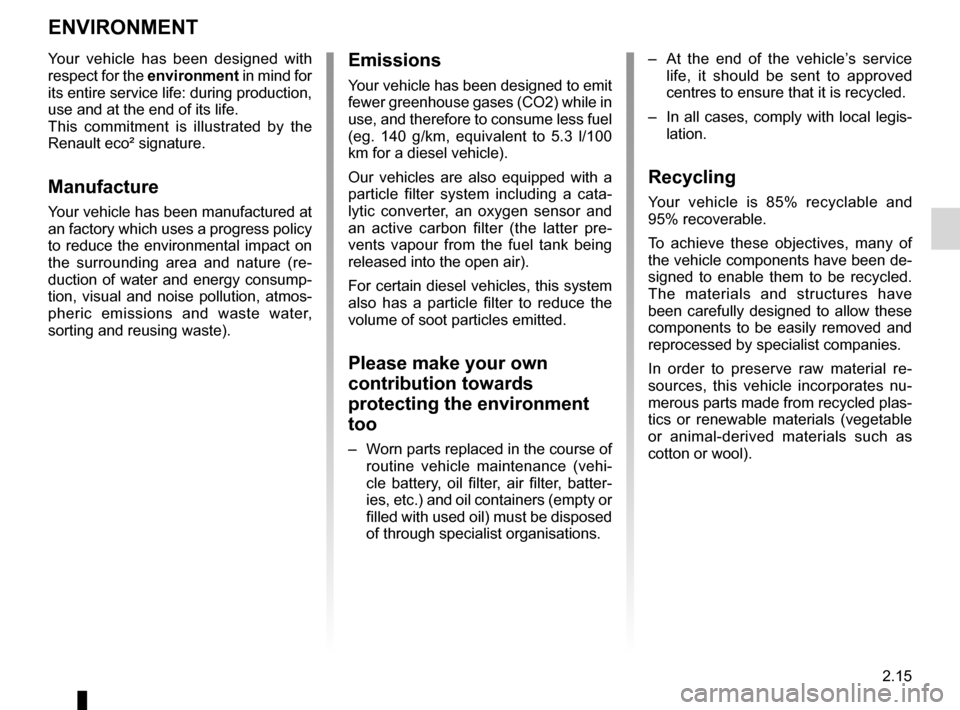
environment .......................................... (up to the end of the DU)
2.15
ENG_UD25716_1
Environnement (sans marque) (X44 - X45 - X77 - X81 - X85 - X90 - X91 \
- X83 - X61 - TEST - X95 - J95 - R95 - F90 Ph2 - X33 - X47 - X43 - X38 - H79 - X62 - X32 -\
X09 -
ENG_NU_932-3_X81ph3_Renault_2
Environment
ENvIRONMENT
Emissions
Your vehicle has been designed to emit
fewer greenhouse gases (CO2) while in
use, and therefore to consume less fuel
(eg. 140 g/km, equivalent to 5.3 l/100
km for a diesel vehicle).
Our vehicles are also equipped with a
particle filter system including a cata -
lytic converter, an oxygen sensor and
an active carbon filter (the latter pre -
vents vapour from the fuel tank being
released into the open air).
For certain diesel vehicles, this system
also has a particle filter to reduce the
volume of soot particles emitted.
Please make your own
contribution towards
protecting the environment
too
– Worn parts replaced in the course of
routine vehicle maintenance (vehi -
cle battery, oil filter, air filter, batter -
ies, etc.) and oil containers (empty or
filled with used oil) must be disposed
of through specialist organisations. –
At the end of the vehicle’s service
life, it should be sent to approved
centres to ensure that it is recycled.
– In all cases, comply with local legis -
lation.
Recycling
Your vehicle is 85% recyclable and
95% recoverable.
To achieve these objectives, many of
the vehicle components have been de-
signed to enable them to be recycled.
The materials and structures have
been carefully designed to allow these
components to be easily removed and
reprocessed by specialist companies.
In order to preserve raw material re -
sources, this vehicle incorporates nu -
merous parts made from recycled plas-
tics or renewable materials (vegetable
or animal-derived materials such as
cotton or wool).
Your vehicle has been designed with
respect for the
environment in mind for
its entire service life: during production,
use and at the end of its life.
This commitment is illustrated by the
Renault eco² signature.Manufacture
Your vehicle has been manufactured at
an factory which uses a progress policy
to reduce the environmental impact on
the surrounding area and nature (re -
duction of water and energy consump-
tion, visual and noise pollution, atmos-
pheric emissions and waste water,
sorting and reusing waste).
Page 98 of 267
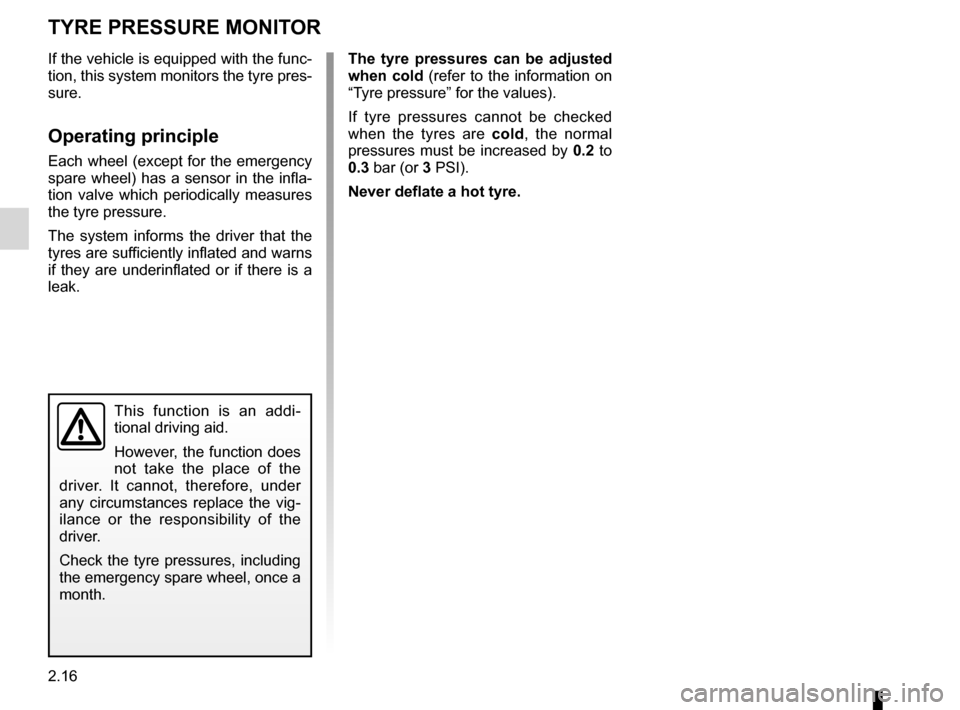
tyres ....................................................................... (current page)
tyre pressure .......................................................... (current page)
tyre pressure monitor ............................................. (current page)
driving ................................................... (up to the end of the DU)
2.16
ENG_UD20370_1
Système de surveillance de pression des pneus (X81 - J81 - Renault)\
ENG_NU_932-3_X81ph3_Renault_2
Jaune NoirNoir texte
Tyre pressure monitor
TYRE PRESSURE MONITOR
If the vehicle is equipped with the func-
tion, this system monitors the tyre pres-
sure.
Operating principle
Each wheel (except for the emergency
spare wheel) has a sensor in the infla-
tion valve which periodically measures
the tyre pressure.
The system informs the driver that the
tyres are sufficiently inflated and warns
if they are underinflated or if there is a
leak.
This function is an addi -
tional driving aid.
However, the function does
not take the place of the
driver. It cannot, therefore, under
any circumstances replace the vig -
ilance or the responsibility of the
driver.
Check the tyre pressures, including
the emergency spare wheel, once a
month.
The tyre pressures can be adjusted
when cold (refer to the information on
“Tyre pressure” for the values).
If tyre pressures cannot be checked
when the tyres are cold, the normal
pressures must be increased by 0.2 to
0.3 bar (or 3 PSI).
Never deflate a hot tyre.
Page 99 of 267
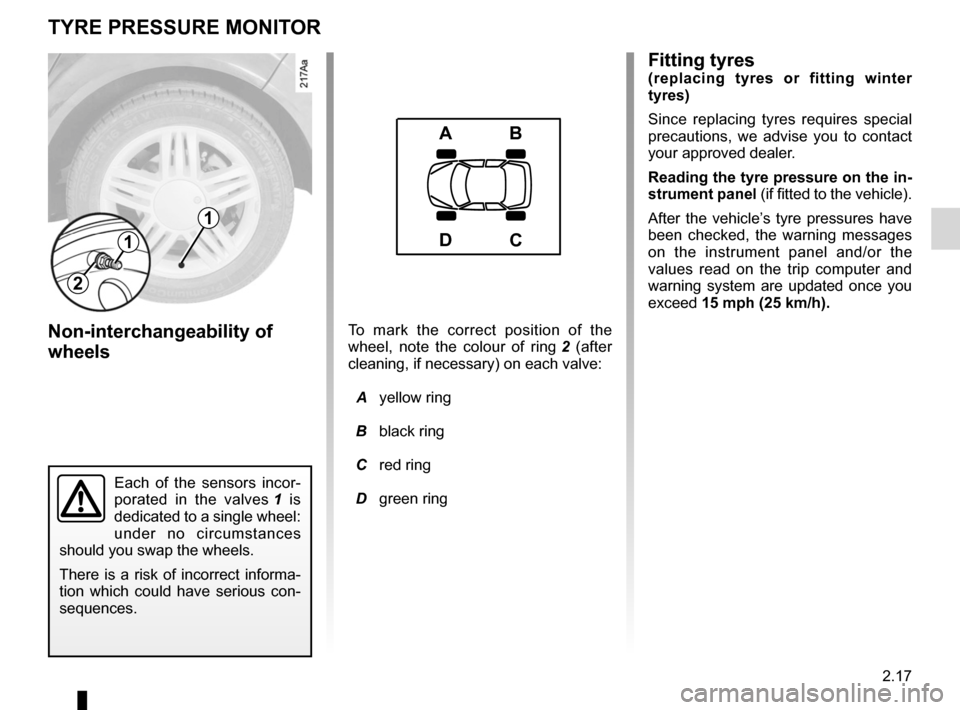
JauneNoirNoir texte
2.17
ENG_UD20370_1
Système de surveillance de pression des pneus (X81 - J81 - Renault)\
ENG_NU_932-3_X81ph3_Renault_2
TYRE PRESSURE MONITOR
Fitting tyres(replacing tyres or fitting winter
tyres)
Since replacing tyres requires special
precautions, we advise you to contact
your approved dealer.
Reading the tyre pressure on the in-
strument panel (if fitted to the vehicle).
After the vehicle’s tyre pressures have
been checked, the warning messages
on the instrument panel and/or the
values read on the trip computer and
warning system are updated once you
exceed 15 mph (25 km/h).
Non-interchangeability of
wheels
Each of the sensors incor -
porated in the valves 1 is
dedicated to a single wheel:
under no circumstances
should you swap the wheels.
There is a risk of incorrect informa-
tion which could have serious con -
sequences.
To mark the correct position of the
wheel, note the colour of ring 2 (after
cleaning, if necessary) on each valve:
A yellow ring
B black ring
C red ring
D green ring
AB
Dc1
2
1
Page 100 of 267
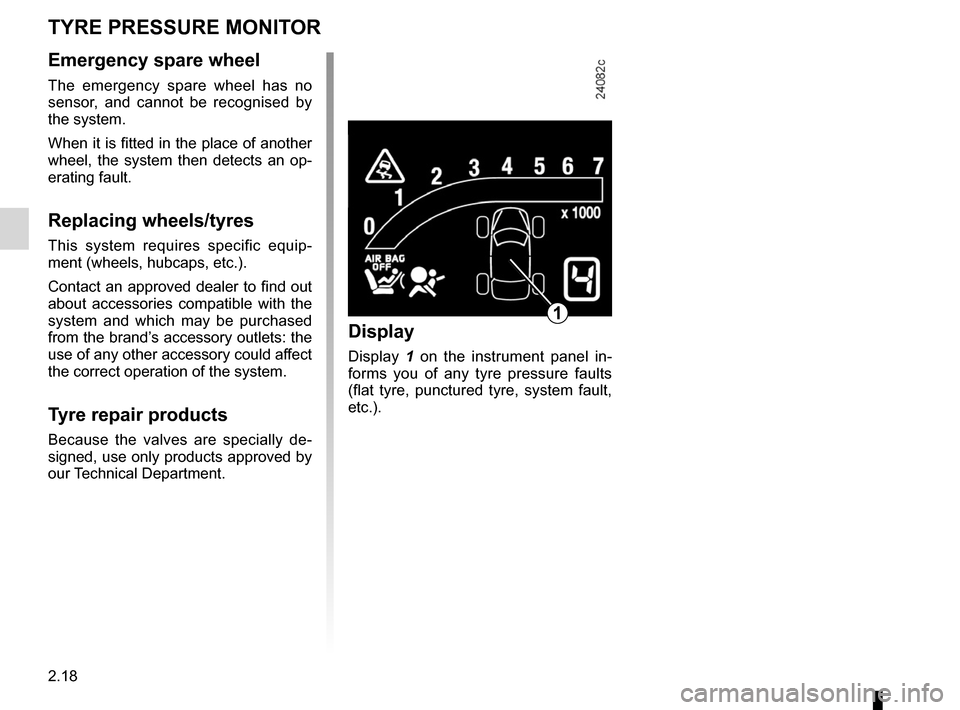
2.18
ENG_UD20370_1
Système de surveillance de pression des pneus (X81 - J81 - Renault)\
ENG_NU_932-3_X81ph3_Renault_2
Jaune NoirNoir texte
TYRE PRESSURE MONITOR
Emergency spare wheel
The emergency spare wheel has no
sensor, and cannot be recognised by
the system.
When it is fitted in the place of another
wheel, the system then detects an op-
erating fault.
Replacing wheels/tyres
This system requires specific equip -
ment (wheels, hubcaps, etc.).
Contact an approved dealer to find out
about accessories compatible with the
system and which may be purchased
from the brand’s accessory outlets: the
use of any other accessory could affect
the correct operation of the system.
Tyre repair products
Because the valves are specially de -
signed, use only products approved by
our Technical Department.
Display
Display 1 on the instrument panel in -
forms you of any tyre pressure faults
(flat tyre, punctured tyre, system fault,
etc.).
1
Page 101 of 267
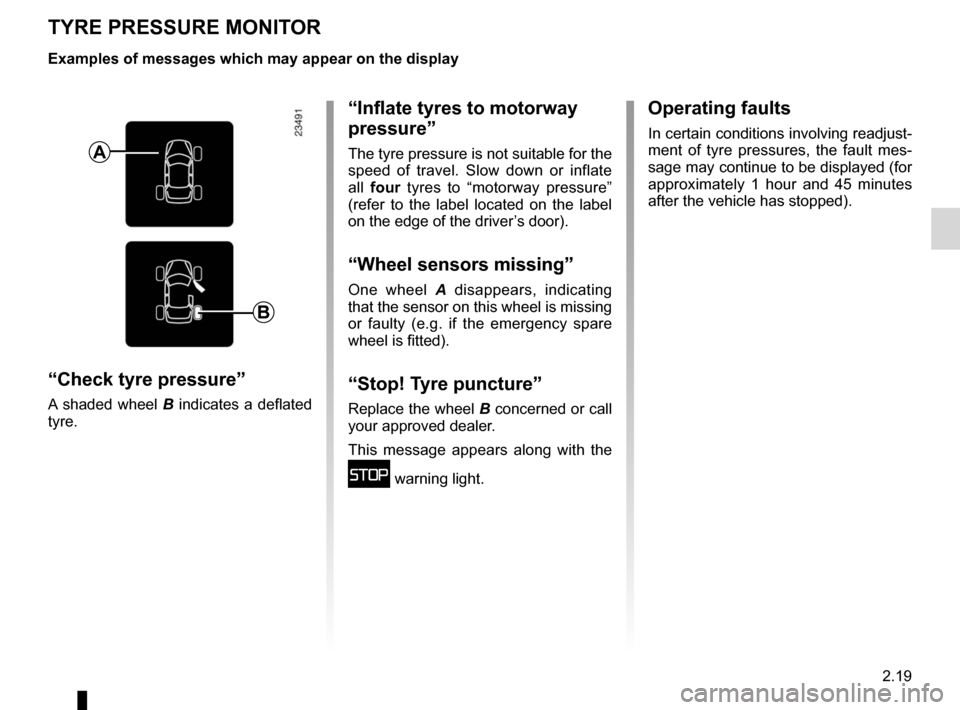
JauneNoirNoir texte
2.19
ENG_UD20370_1
Système de surveillance de pression des pneus (X81 - J81 - Renault)\
ENG_NU_932-3_X81ph3_Renault_2
TYRE PRESSURE MONITOR
“check tyre pressure”
A shaded wheel B indicates a deflated
tyre.
“Inflate tyres to motorway
pressure”
The tyre pressure is not suitable for the
speed of travel. Slow down or inflate
all four tyres to “motorway pressure”
(refer to the label located on the label
on the edge of the driver’s door).
“Wheel sensors missing”
One wheel A disappears, indicating
that the sensor on this wheel is missing
or faulty (e.g. if the emergency spare
wheel is fitted).
“Stop! Tyre puncture”
Replace the wheel B concerned or call
your approved dealer.
This message appears along with the
û warning light.
Operating faults
In certain conditions involving readjust-
ment of tyre pressures, the fault mes -
sage may continue to be displayed (for
approximately 1 hour and 45 minutes
after the vehicle has stopped).
A
B
Examples of messages which may appear on the display
Page 102 of 267
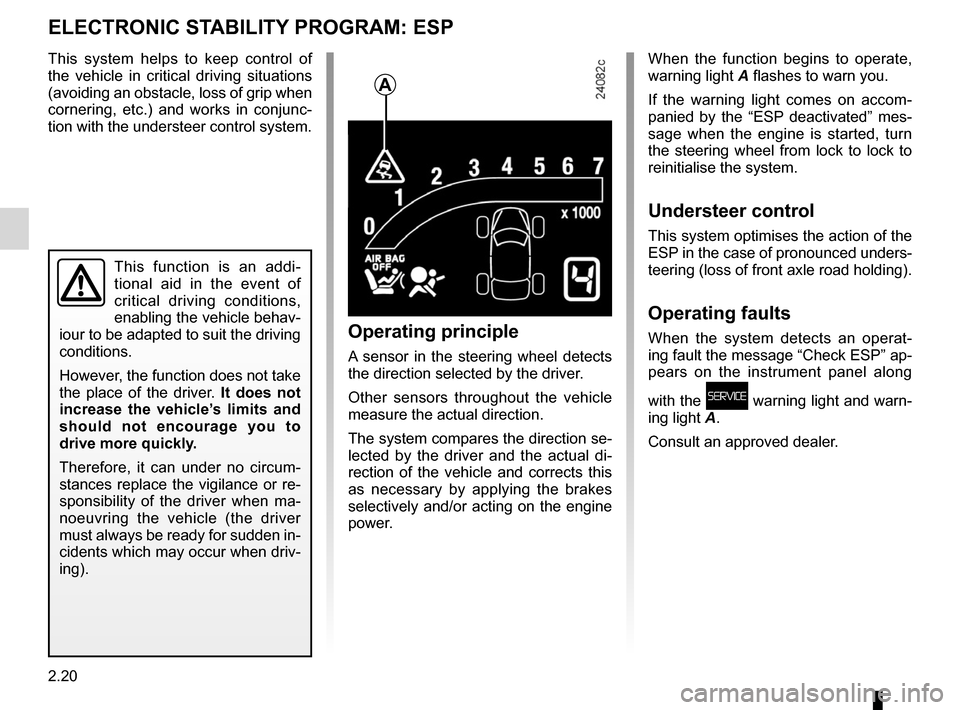
Electronic Stability Program: ESP ........ (up to the end of the DU)
ESP: Electronic Stability Program ........ (up to the end of the DU)
2.20
ENG_UD20371_1
Contrôle dynamique de conduite : E.S.P. avec contrôle de sous-virage (X81 - J81 - Renault)
ENG_NU_932-3_X81ph3_Renault_2
Electronic Stability Program: ESP
ELEcTRONIc STABILITY PROGRAM: ESP
This system helps to keep control of
the vehicle in critical driving situations
(avoiding an obstacle, loss of grip when
cornering, etc.) and works in conjunc -
tion with the understeer control system.
This function is an addi -
tional aid in the event of
critical driving conditions,
enabling the vehicle behav -
iour to be adapted to suit the driving
conditions.
However, the function does not take
the place of the driver. It does not
increase the vehicle’s limits and
should not encourage you to
drive more quickly.
Therefore, it can under no circum -
stances replace the vigilance or re-
sponsibility of the driver when ma -
noeuvring the vehicle (the driver
must always be ready for sudden in-
cidents which may occur when driv-
ing).
Operating principle
A sensor in the steering wheel detects
the direction selected by the driver.
Other sensors throughout the vehicle
measure the actual direction.
The system compares the direction se-
lected by the driver and the actual di -
rection of the vehicle and corrects this
as necessary by applying the brakes
selectively and/or acting on the engine
power. When the function begins to operate,
warning light
A flashes to warn you.
If the warning light comes on accom -
panied by the “ESP deactivated” mes -
sage when the engine is started, turn
the steering wheel from lock to lock to
reinitialise the system.
Understeer control
This system optimises the action of the
ESP in the case of pronounced unders-
teering (loss of front axle road holding).
Operating faults
When the system detects an operat -
ing fault the message “Check ESP” ap-
pears on the instrument panel along
with the
ú warning light and warn-
ing light A.
Consult an approved dealer.
A
Page 103 of 267
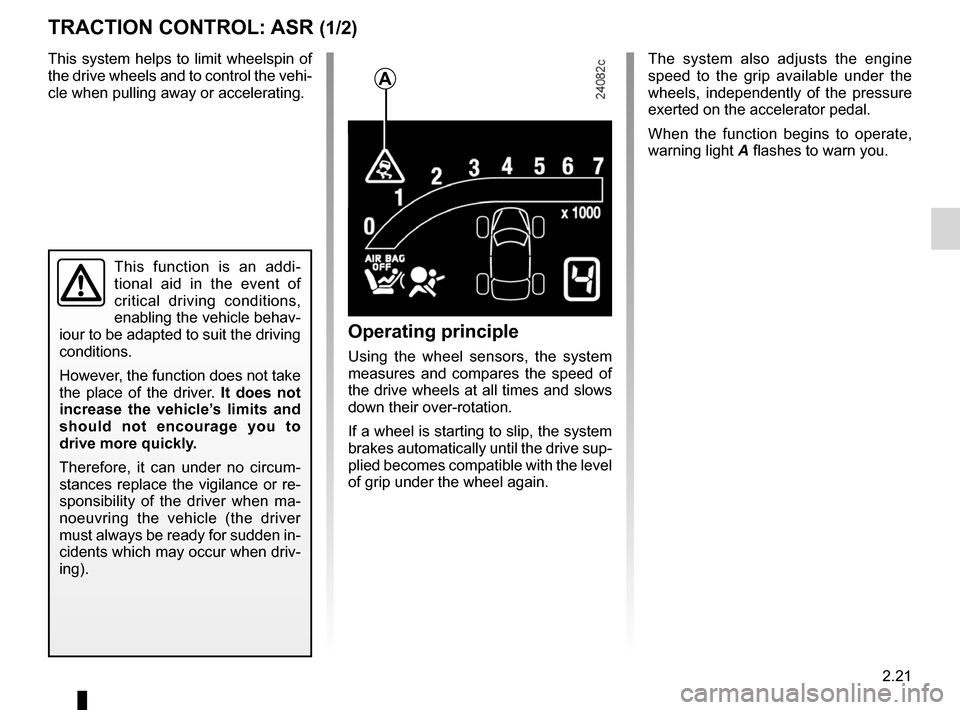
traction control ...................................... (up to the end of the DU)
traction control: ASR .............................(up to the end of the DU)
driving ................................................... (up to the end of the DU)
2.21
ENG_UD20372_1
Système antipatinage : A.S.R. (X81 - J81 - Renault)
ENG_NU_932-3_X81ph3_Renault_2
Traction control: ASR
TRAcTION cONTROL: ASR (1/2)
This system helps to limit wheelspin of
the drive wheels and to control the vehi-
cle when pulling away or accelerating.
This function is an addi -
tional aid in the event of
critical driving conditions,
enabling the vehicle behav -
iour to be adapted to suit the driving
conditions.
However, the function does not take
the place of the driver. It does not
increase the vehicle’s limits and
should not encourage you to
drive more quickly.
Therefore, it can under no circum -
stances replace the vigilance or re-
sponsibility of the driver when ma -
noeuvring the vehicle (the driver
must always be ready for sudden in-
cidents which may occur when driv-
ing).
Operating principle
Using the wheel sensors, the system
measures and compares the speed of
the drive wheels at all times and slows
down their over-rotation.
If a wheel is starting to slip, the system
brakes automatically until the drive sup-
plied becomes compatible with the level
of grip under the wheel again. The system also adjusts the engine
speed to the grip available under the
wheels, independently of the pressure
exerted on the accelerator pedal.
When the function begins to operate,
warning light
A flashes to warn you.
A
Page 107 of 267
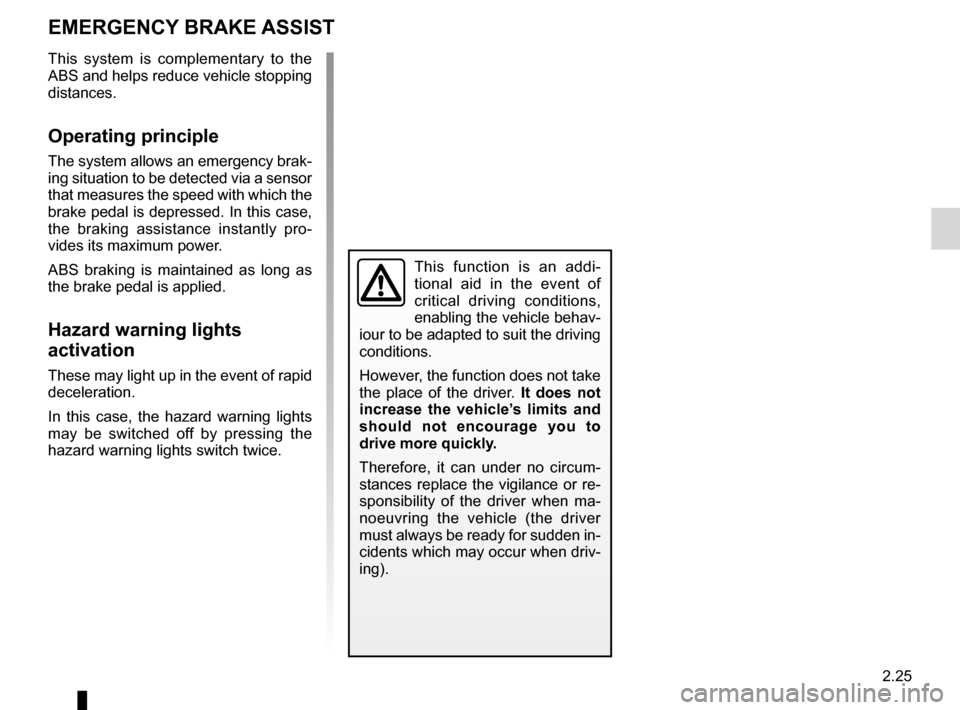
emergency brake assist......................................... (current page)
emergency braking ............................... (up to the end of the DU)
driving ................................................... (up to the end of the DU)
2.25
ENG_UD1792_1
Assistance au freinage d’urgence (X81 - Renault)
ENG_NU_932-3_X81ph3_Renault_2
Assistance au freinage d’urgence
EMERGENcY BRAKE ASSIST
This system is complementary to the
ABS and helps reduce vehicle stopping
distances.
Operating principle
The system allows an emergency brak-
ing situation to be detected via a sensor
that measures the speed with which the
brake pedal is depressed. In this case,
the braking assistance instantly pro -
vides its maximum power.
ABS braking is maintained as long as
the brake pedal is applied.
Hazard warning lights
activation
These may light up in the event of rapid
deceleration.
In this case, the hazard warning lights
may be switched off by pressing the
hazard warning lights switch twice.
This function is an addi -
tional aid in the event of
critical driving conditions,
enabling the vehicle behav -
iour to be adapted to suit the driving
conditions.
However, the function does not take
the place of the driver. It does not
increase the vehicle’s limits and
should not encourage you to
drive more quickly.
Therefore, it can under no circum -
stances replace the vigilance or re-
sponsibility of the driver when ma -
noeuvring the vehicle (the driver
must always be ready for sudden in-
cidents which may occur when driv-
ing).